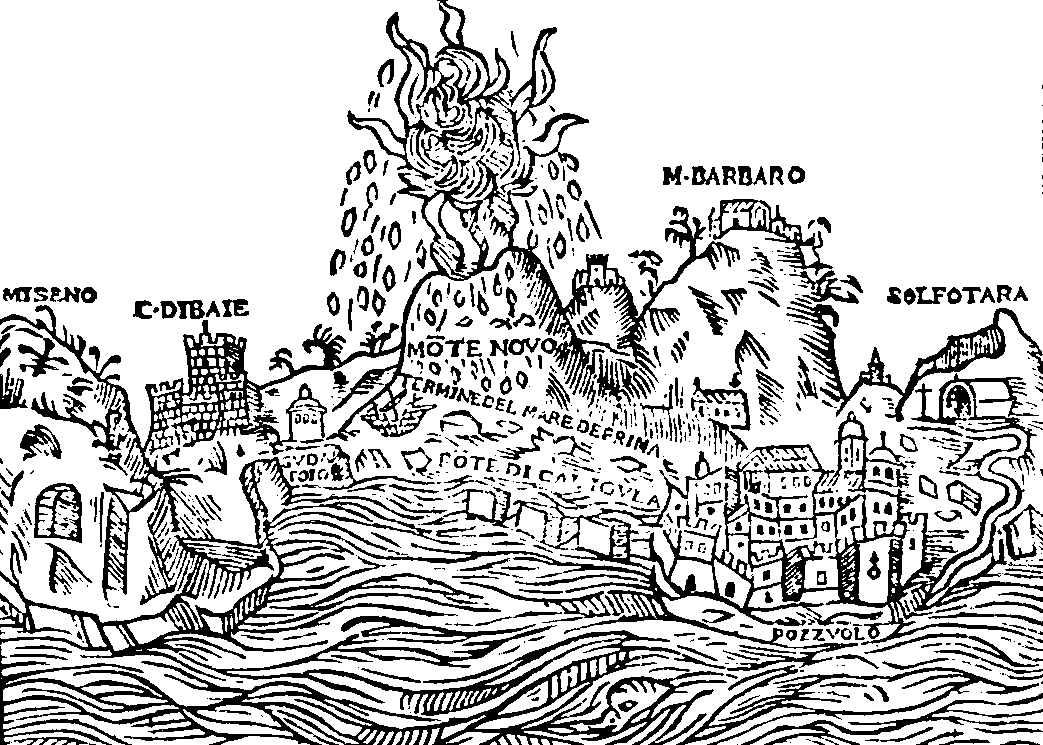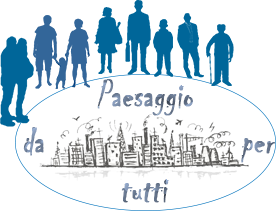
Landscape at Risk
RECHARGED
EN-ROUTE INTERNATIONAL SEMINAR
Pozzuoli, 7th-9th June 2021
NEWs and UPDATES

LETTURE |
 Read more > |
Landscape at Risk |
 Bando 2019-2020 PROGETTO PILOTA Paesaggio da tutti - Paesaggio per tutti Formazione ed educazione per la consapevolezza delle nuove generazioni Read more > COMUNICAZIONI > |
|
THE NEW CONTEXT
The international seminar Landscape at Risk was originally launched in November 2019 and was scheduled to take place at the end of May 2020. Due to the pandemic the event had to be postponed, with its organization and format adapted to the new context. The seminar will now be held in June 2021 in blended mode, i.e. there will be a physical conference venue in Naples and participants who wish/are able to come to Naples are welcome. Otherwise it will be possible to participate and develop a presentation via the web.
During this long year the Organizational Committee has collected and selected the full papers, submitted them to double blind peer review and printed them in two volumes. Furthermore, we have conceived a new formula with many appealing events described below.
Post-pandemic landscapes at risk
The pandemic has changed our daily lives and habits: how we work, learn and interact. Social distancing guidelines have led to a more virtual existence, both personally and professionally. Landscapes have obviously been affected, not only in the way they are perceived but also as regards the intensity of the phenomena that usually put them at risk (i.e. abandonment, tourism) or our understanding of risks and the way to cope with them.
Participants are asked to provide, at the end of their presentation, some food for thought concerning post-pandemic landscapes at risk with reference to the topics they have covered. Considerations coming from participants will be included in the Selected Lectures on Landscapes at Risk described here below.
Landscape at Risk Prize and Publication of “Selected Lectures on Landscapes at Risk”
Among the contributions presented during the sessions of the seminar, the best paper will be selected for each session. Authors of selected papers will be invited to submit an extended version of their contribution for the Selected Lectures on Landscapes at Risk. The book will collect comments and reflections on the topics of the seminar, as well as selected suggestions coming from the keynote speakers, roundtable speakers and participants.
Southern Italian Landscapes at Risk Video Call
The UNISCAPE Napoli Federico II group intends to build up a media archive on Southern Italian Landscapes at Risk. For this purpose, a call for videos is launched. All the details are provided in the attached file.
We hope you will enjoy the Landscape at Risk Seminar in its new version!
TOPICS
The European Landscape Convention (ELC) has yielded important results by promoting approaches oriented to landscape conservation and enhancement. Nevertheless, in the present context, risks and hazards threatening landscape resources have increased at an alarming rate: environmental risks intensified by unregulated urban development, climate change, excessive landscape exploitation or, on the other hand, landscape abandonment and depopulation.
Twenty years on from the enactment of the ELC, the seminar sets out to take stock of how much is still required to cope with all the different forms of risk threatening “the significant or characteristic features of a landscape, justified by its heritage value derived from its natural configuration and/or from human activity” (ELC, 2000).
The seminar aims to deal with all the different factors that can cause alteration, degradation, depletion or loss of material and immaterial assets that mark out landscapes. Therefore, risk is also understood as risk of alteration or interruption of the relationship between community and places which leads to creating landscape features in the first place.
The issue “Landscapes at risk” will be addressed in its many meanings, starting from landscapes affected by natural risks, moving to those suffering from shrinkage or gentrification, or even overexploitation and/or congestion, up to landscapes in transition.
PLENARY SESSIONS
1. Landscapes and Environmental Risks
This session analyzes landscapes affected by natural risks, from technical, organizational and social standpoints. Landscapes are modelled by risks in many different ways. Some types of risk shape landscape topography and influence the characteristics of the natural environment (i.e. volcanic and hydro-geological risks), promoting specific economic activities more than others, generating population movements/settlements. Other types, such as pollution risk, can significantly affect biotic and abiotic factors of landscape and threaten population health and well-being. Furthermore, grey works to combat hazards (i.e. raised river banks, retaining walls, etc.) can distort landscape features. To reduce the impact of landscape alteration due to risk prevention new solutions that are landscape-sensitive have been set up and local knowledge in dealing with disasters is reconsidered as a welcome supplement to scientific knowledge. Indeed, there is an expanding body of knowledge on locally rooted strategies for risk mitigation which can point to environment-friendly solutions in dealing with hazards.
Furthermore, the presence of a permanent condition of risk affects the relationship between inhabitants and their environment and the way people experience places under the constant threat of hazard; while some places are abandoned by the population after a disaster, in others people return to hazardous areas to rebuild their homes and their livelihoods. Sense of belonging, cultural identity, risk and landscape perception and representation, on the one hand, and social networks, information channels and risk communication modalities, on the other, should be considered before and after a disaster, and merit special attention in disaster risk reduction strategies. Special attention should also be paid to cultural heritage and landscape features that are representative of identity and pride, requiring proactive consideration in post-disaster recovery. Conservation of heritage and landscape features plays a significant role in social cohesion and sustainable development, especially in times of crisis.
The pandemic has focused our attention on a new natural risk –biological risk- that Europe thought it had overcome. A new research agenda on disaster risk reduction has been tabled. Can the pandemic be tackled by using some tools and strategies from the field of disaster risk reduction? Is it possible to identify areas most prone to risk? Do certain elements increase resilience? What strategies can be implemented to avoid future emergencies? What weaknesses and what strengths have emerged in regions while combating the pandemic?
TOPICS
The debate will focus on:
- techniques and actions to prevent/mitigate risks that are respectful of landscape features;
- traditional techniques and customary practices to deal with hazards;
- risk in everyday life and community resilience underpinning landscape creation;
- examples of post-disaster reconstruction which are consistent with landscape features;
The pandemic as a natural risk will be discussed.
2. Landscapes at Risk of Abandonment
All over Europe there are extensive cultural landscapes at risk of depopulation. These landscapes typically belong to peripheral areas isolated from the main development dynamics. They have gradually become marginalised due to decline of the local economy and depopulation. Frequently such areas conserve unspoilt natural environments with a rich cultural and historical heritage comprising a network of small historical centres, as well as abundant high-quality agricultural products and knowledge and skills utilised in traditional ways. This heritage is at risk since population decline is leading to the abandonment of such areas with the consequent decay of tangible cultural heritage. These settlements play an important role in conserving such landscapes. They are custodians of memory and beauty, and their depopulation has led to decay of places, an emptying of relationships, and desertification of the environment and culture.
The broken link between generations, between the young and old, prevents the natural transmission of local knowledge. Such areas are often lacking in accessibility, have scarce economic visibility, low levels of enterprise, and have difficulty becoming part of effective economic hubs. The global economy favours the concentration of assets in big cities, producing of traditional knowledge, which is based on previous experience, and drives the loss of intangible heritage comprising traditional skills, social organization forms, awareness, understanding and ability to use natural resources. The loss of intangible heritage with the associated culture, memories, skills, knowledge and embedded sense of identity linked to such landscapes may further compromise the competitiveness of these regions. New ways of thinking and living, and new approaches to the built environment, are required to give new chances to such areas, using culture and traditional local resources as leverage for new tailored development.
The pandemic has given way to new scenarios for the revitalization of these landscapes and new development paths seem to have opened up within the emergency, where the elements that are traditionally considered weaknesses for economic growth become the strengths of a new concept of development, the starting point of a “different” development pattern, perhaps possible after the pandemic.
The boom in home working due to the COVID-19 pandemic, however, could mean a reversal of such negative trends. Lockdowns that trap city dwellers and users in small apartments have made village life more appealing due to the ability of country living to provide attractive vistas, fresh air and more space for social distancing. Small towns are seeing an influx of new residents and homeowners looking to take advantage of a slower pace of life. The crucial question is whether this trend will be confirmed even when the pandemic is definitively vanquished.
TOPICS
The debate will focus on research aimed at implementing methodologies to quantify the risk of abandonment and at identifying innovative patterns for the revitalisation and regeneration of landscapes at risk. We also invite presentations and case studies regarding the implementation of methodological tools for re-developing abandoned landscapes, mainly based on creating networks able to systematize and revitalize landscape resources. Issues will include:
- engagement of local community (e.g. new forms of inclusion, hospitality projects, innovative agriculture, etc.);
- triggering intercultural and intergenerational dialogue to cope with the loss of heritage;
- exploitation of the various resources held by these landscapes;
- examples of development based on natural and culture-driven hybridization.
A special focus on new perspectives after the pandemic will be developed.
3. Climate Change Mitigation and Adaptation for Urban and Rural Landscapes
Spatial development processes and climate change are the main processes that lead to an increased level of risk for urban and rural landscapes. In particular, extreme hydro-meteorological events are increasing in frequency and intensity, generating dramatic negative impacts on ecosystems and increasing hazards from other risks, such as fires, sea-level rise and biodiversity loss.
Climate change has also altered the value system through which local communities traditionally interact with the landscape, a change which can be perceived both negatively and positively. While climate change is one of the main causes of rapidly changing landscape scenarios, adaptation and mitigation strategies can become themselves drivers of profound land transformations.
The need to tackle climate-related risk has been pushing researchers, local authorities and policy makers to find and test viable solutions to mitigate the negative effects of climate change and make landscapes more resilient to such effects. The implementation of solutions will significantly modify urban and rural landscape and its perception by communities. Examples of sustainable solutions that can transform the relation between the landscape and its community can be found at urban scale, such as the implementation of sustainable mobility-oriented traffic policies (e.g. restricted traffic areas, bike lanes, etc.) or nature-based solutions. At a wider scale, climate-sensitive management of agricultural practices (e.g. by shifting to crops with higher carbon storage potential or reducing forest clearing for agricultural expansion) can contribute to a significant reduction in CO2 emissions.
The pandemic has generated considerable awareness that the need to re-establish a more balanced relationship between humankind and nature can no longer be ignored. During lockdowns everyone has perceived an unexpected and sudden return of some aspects of nature in the city. In the aftermath there has been an increasing demand for green spaces and sustainable mobility. In Europe new financial opportunities have emerged to combat CC.
TOPICS
This session presents contributions investigating how to ensure a climate change risk reduction with landscape preservation and enhancement. We particularly encourage contributions presenting:
- methodological improvements or new modelling approaches to support strategies, measures or actions for the mitigation and adaptation of rural and urban landscapes.
- case studies and experiences on urban planning and design, at national or international level and at different scales and extents, dealing with nature-driven urban and landscape regeneration (Nature based solutions, green and blue infrastructure, ecosystem services, and soil de-sealing).
An update on new demands and new opportunities after the pandemic will be developed.
4. Landscape at Risk of Overexploitation and Tourism
The levels of exploitation of the landscape are causing unprecedented changes in the configuration and perception of places, in the maintenance of ecosystems and biodiversity, as well as in social and cultural alterations. The enjoyment of rural, coastal, mountain and urban landscapes is a resource of enormous value that is a great attractor for tourism of every category, whether for cultural and natural heritage or recreation. However, the paradox is that the development of tourism through infrastructures, building densification, transformation of urban space, transformation of tertiary activities and coastal resorts, has a devastating impact on the main attraction, namely landscape, in its multiple manifestations and material and immaterial features.
Overexploitation of resources can be seen in every territorial setting: in peri-urban degraded settlements, in historical urban centres transformed into tourist resorts, and in rural areas modified by intensive crops.
Before the pandemic uncontrolled tourist development represented, albeit in a small percentage, a threat to the balance of nature; a recent study, published by the journal Nature Climate Change [2018], estimated that tourism was responsible for 8% of the global economy's carbon dioxide emissions.
Tourism was a worldwide phenomenon in strong expansion and transformation prior to the pandemic, producing unexpected changes in the social, economic and environmental fields (ISPRA, 2017). At the same time, it has been one of the economic sectors most affected by the pandemic. International tourism is expected to fall by around 80% in 2020. Destinations that mainly rely on international, business and events tourism, as well as art cities, are particularly struggling. The past year has witnessed bans on travel abroad and even within the same country, failure of airlines and travel agencies, and an end to the spread of B&Bs. Yet a predominant aspect is the fear of travel. There is no knowing whether tourism that was for many countries one of their economic mainstays will ever recover from the crisis. To be fair, domestic and proximity tourism, which were previously a lesser phenomenon, have been slowly restarting and helping to mitigate the impact on jobs and businesses in some destinations. Perhaps this is the time to wonder whether a new tourism would be possible after the pandemic, a tourism for the “sober enjoyment” of the man-made and/or natural landscape, through controlled exploitation of the resource: a tourism respecting the “delicate balance” between conservation of the natural environment and its use without destroying identity and local cultures. In this respect, many countries are currently trying to develop measures to build a more resilient post-COVID-19 tourist economy. These include making plans to support the sustainable recovery of tourism, promoting the digital transition and moving to a greener tourism system, and rethinking tourism for the future (OECD, 2020).
TOPICS
The debate will focus on:
- examples, proposals, case studies of tourism development patterns that are consistent with material and immaterial values of landscapes and strategic responses to enhance the ability of areas or regions to manage and recover from tourism shocks and to cope with the loss of identity;
- identifying and evaluating direct, indirect and induced impacts on local communities and how both “progressive” and “conservative” actors, movements, scholars tackle such challenges and their conflicting perspectives;
- the management and use of cultural heritage;
- exploitation of landscape resources;
- innovative approaches to mitigate poor landscape quality of new intervention/development.
Special attention will be paid to new scenarios for tourism after the pandemic.
VENUE
University of Naples Federico II, Italy
The re-scheduled seminar will be held in June 2021 in blended modality, i.e. there will be a physical conference venue in a specially equipped building of the University of Naples “Federico II” and participants who wish/are able to come to Naples are welcome. Otherwise, it will be possible to participate and develop a presentation via the web.
DRAFT PROGRAM
Monday 7th June 2021
Welcome Speech
Keynote speaker session
Session Landscapes and Environmental Risks
Session Climate Change Mitigation and Adaptation for Urban and Rural Landscapes
Tuesday 8th June 2021
Session Landscapes at Risk of Abandonment
Session Landscapes at Risk of Overexploitation and Tourism
Southern Italian Landscapes at Risk Video
Campania Region Landscape Planning Presentation
Wednesday 9th June 2021
Roundtable “New Perspectives for Landscapes at Risk”
Landscape at Risk Prize
CALL FOR ABSTRACT
Call for abstract is closed.
CALL FOR VIDEO
The UNISCAPE Napoli group intends to build up a media archive on Southern Italian Landscapes at Risk. For this purpose, a call for videos is launched. All the details and deadlines are provided in the attached file.
IMPORTANT DATES AND DEADLINES
In order to finalize the seminar programme, participants are asked to send confirm their physical or virtual presence by May 15th and submit their presentation to infouniscape@unina.it by May 28th 2021.
PROCEEDINGS AND FINAL BOOK
The papers submitted for the Landscape at Risk En-Route Seminar 2020 have already been peer-reviewed and published in the Special Issue No. 4 of Sustainable Mediterranean Construction, a journal indexed in Scopus (ISSN 2420-8213). Volume 1 was published in July 2020. Volume 2 is almost ready to be published.
At the end of the seminar, Selected Lectures on Landscapes at Risk will be published. It will host an extended version of best papers, as well as selected suggestions from the keynote speakers, roundtable speakers and all the participants, who are asked to provide, at the end of their presentation during the seminar, some food for thought concerning post-pandemic landscapes at risk with reference to the topics they have covered.
Water, Air, Earth, Fire. Southern Italy Landscapes at risk
 EN-ROUTE INTERNATIONAL SEMINAR
EN-ROUTE INTERNATIONAL SEMINAR
Naples, 7th-9th June 2021
CALL FOR VIDEOS

CALL FOR VIDEO
UNISCAPE Napoli “Federico II” intends to create an archive of images on Southern Italian Landscapes at risk, starting from the four natural elements: air, water, earth and fire. The aim is to analyze landscapes as complex places where symbolic elements, perceptions and practices, actors and decisions, possible innovative responses in the direction of environmental and social sustainability intersect. The call is open not only to scholars and researchers, but also to professionals, associations and local authorities interested in bringing out innovative strategic approaches to landscapes at risk in southern Italy.
Videos presented will be published on the website of UNISCAPE Napoli “Federico II” (http://www.uniscape.unina.it) and will form the basis for the production of a very short video, in which the southern landscapes at risk and innovative strategies for reducing their vulnerability will be central. The short film will be shown during the international UNISCAPE seminar to be held in Naples on June 7th, 8th and 9th, 2021.
The chosen landscape has to be defined with respect to the dominant element (water, air, earth, fire) highlighting the prevailing characteristics, defined according to a classification not to be considered exclusive:
- urban/peri-urban/rural landscapes;
- coastal/marine/fluvial/volcanic landscapes;
- underground landscapes;
- archaeological, natural, artistic landscapes;
- wastescapes;
- reclaimed landscapes.
Materials to be delivered
- application form (attached) to be filled in with:
- name, surname, place of residence and professional status/academic affiliation of the author;
- title of the video, dominant element, classification of the landscape;
- 5 keywords;
- abstract (max 1200 characters), which outlines the risk to be tackled and innovative strategies identified for damage control;
- photo and video disclaimer.
- video
Minimum format to send:
- Pictures shot in FULL HD 1920x1080 (recommended duration 10 seconds);
- MP4 - MOV CODEC: H264-H265 FPS: 25 (PAL) - 3 minutes long;
- Shooting with mobile phone horizontally.
IMPORTANT DATES AND DEADLINES
Videos have to be submitted by May 8th 2021, sending an e-mail to the address: infouniscape@unina.it.
If the videos and pictures size exceeds 15 Mb, it might be helpful to use a file transfer service (e.g. wetransfer, dropbox, jumbomail, etc.) and send to infouniscape@unina.it the link to download the files.
SCIENTIFIC COORDINATORS
Elvira Petroncelli, Marialuce Stanganelli, Carlo Gerundo
SCIENTIFIC COMMITTEE
Claus-Peter Echter President, CIVVIH ICOMOS
Christopher Kilburn, University College, London UK
Tana Lascu, “Ion Mincu” University of Architecture and Urban Planning Bucharest Romania
Juanjo Galan Vivas, School of Art, Design and Architecture - Aalto University Finland
Tessa Matteini, University of Florence Italy
Rita Occhiuto, University of Liège, Belgium
Anna Laura Palazzo, University of Rome 3 Italy
Juan Manuel Palerm Salazar, Universidad de Las Palmas de Gran Canaria
Chao Ren, University of Hong Kong
Michelangelo Russo University of Naples Federico II
Patrizia Tassinari,University of Bologna
Daniele Torreggiani,University of Bologna
ORGANIZING COMMITEE
Gilda Berruti DIARC University of Naples Federico II
Francesca Bruni, DICEA University of Naples Federico II
Fabio Corbisiero, DISS University of Naples Federico II
Paola De Joanna, DIARC University of Naples Federico II
Dora Francese, DIARC University of Naples Federico II
Carlo Gerundo, DICEA University of Naples Federico II
Daniele La Rosa DICAR University of Catania
Elvira Petroncelli, DICEA University of Naples Federico II
Michelangelo Russo DIARC University of Naples Federico II
Marialuce Stanganelli, DIARC University of Naples Federico II
Anna Maria Zaccaria, DISS University of Naples Federico II
INFORMATION CONTACTS
Marina d ’Ambrosio (mardambr@unina.it,infouniscape@unina.it, +39 081 7682322)
Website: www.uniscape.unina.it; www.uniscape.eu; www.osservatorioturismo.com
